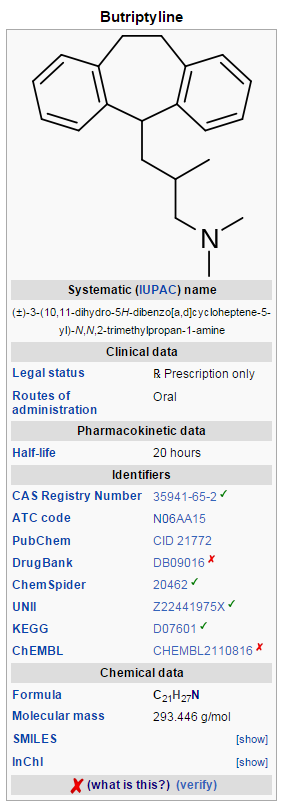Butriptyline
|
WikiDoc Resources for Butriptyline |
|
Articles |
|---|
|
Most recent articles on Butriptyline Most cited articles on Butriptyline |
|
Media |
|
Powerpoint slides on Butriptyline |
|
Evidence Based Medicine |
|
Clinical Trials |
|
Ongoing Trials on Butriptyline at Clinical Trials.gov Clinical Trials on Butriptyline at Google
|
|
Guidelines / Policies / Govt |
|
US National Guidelines Clearinghouse on Butriptyline
|
|
Books |
|
News |
|
Commentary |
|
Definitions |
|
Patient Resources / Community |
|
Patient resources on Butriptyline Discussion groups on Butriptyline Patient Handouts on Butriptyline Directions to Hospitals Treating Butriptyline Risk calculators and risk factors for Butriptyline
|
|
Healthcare Provider Resources |
|
Causes & Risk Factors for Butriptyline |
|
Continuing Medical Education (CME) |
|
International |
|
|
|
Business |
|
Experimental / Informatics |
Editor-In-Chief: C. Michael Gibson, M.S., M.D. [1]
Overview
Butriptyline (Evadene, Evadyne, Evasidol, Centrolese) is a tricyclic antidepressant (TCA) which has been used in Europe since 1974.[1][2][3][4][5] It is the isobutyl side chain homologue of amitriptyline and produces similar effects to it, but with less marked side effects like sedation and interactions with adrenergic drugs.[1][5][6]
In vitro, butriptyline is a strong antihistamine and anticholinergic, moderate 5-HT2 and α1-adrenergic receptor antagonist, and weak serotonin reuptake inhibitor, with negligible affinity for the norepinephrine and dopamine transporters.[7][8][9] These actions appear to confer a profile similar to that of iprindole and trimipramine with serotonin-blocking effects as the predominant mediator of mood-lifting efficacy.[10][11][12]
However, in clinical trials, using similar doses, butriptyline was found to be even more effective than amitriptyline as an antidepressant, despite the fact that amitriptyline is much, much stronger as both a 5-HT2 antagonist and serotonin-norepinephrine reuptake inhibitor.[7][8][9][13] As a result, it may be that butriptyline, in vivo, functions as a prodrug to a metabolite with more appreciable pharmacodynamics.
References
- ↑ 1.0 1.1 José Miguel Vela; Helmut Buschmann; Jörg Holenz; Antonio Párraga; Antoni Torrens (2007). Antidepressants, Antipsychotics, Anxiolytics: From Chemistry and Pharmacology to Clinical Application. Weinheim: Wiley-VCH. p. 180. ISBN 3-527-31058-4.
- ↑ Swiss Pharmaceutical Society (2000). Index Nominum 2000: International Drug Directory (Book with CD-ROM). Boca Raton: Medpharm Scientific Publishers. ISBN 3-88763-075-0.
- ↑ Sittig, Marshall (1988). Pharmaceutical manufacturing encyclopedia. Park Ridge, N.J., U.S.A: Noyes Publications. p. 213. ISBN 0-8155-1144-2.
- ↑ Dictionary of organic compounds. London: Chapman & Hall. 1996. p. 1157. ISBN 0-412-54090-8.
- ↑ 5.0 5.1 Paykel, Eugene S. (1992). Handbook of affective disorders. New York: Guilford Press. p. 339. ISBN 0-89862-674-9.
- ↑ Aronson, Jeffrey Kenneth (2008). Meyler's Side Effects of Psychiatric Drugs (Meylers Side Effects). Amsterdam: Elsevier Science. ISBN 0-444-53266-8.
- ↑ 7.0 7.1 Richelson E, Nelson A (July 1984). "Antagonism by antidepressants of neurotransmitter receptors of normal human brain in vitro". The Journal of Pharmacology and Experimental Therapeutics. 230 (1): 94–102. PMID 6086881.
- ↑ 8.0 8.1 Wander TJ, Nelson A, Okazaki H, Richelson E (December 1986). "Antagonism by antidepressants of serotonin S1 and S2 receptors of normal human brain in vitro". European Journal of Pharmacology. 132 (2–3): 115–21. doi:10.1016/0014-2999(86)90596-0. PMID 3816971.
- ↑ 9.0 9.1 Tatsumi M, Groshan K, Blakely RD, Richelson E (December 1997). "Pharmacological profile of antidepressants and related compounds at human monoamine transporters". European Journal of Pharmacology. 340 (2–3): 249–58. doi:10.1016/S0014-2999(97)01393-9. PMID 9537821.
- ↑ Jaramillo J, Greenberg R (February 1975). "Comparative pharmacological studies on butriptyline and some related standard tricyclic antidepressants". Canadian Journal of Physiology and Pharmacology. 53 (1): 104–12. doi:10.1139/y75-014. PMID 166748.
- ↑ Randrup A, Braestrup C (August 1977). "Uptake inhibition of biogenic amines by newer antidepressant drugs: relevance to the dopamine hypothesis of depression". Psychopharmacology. 53 (3): 309–14. doi:10.1007/BF00492370. PMID 408861.
- ↑ Richelson E, Pfenning M (September 1984). "Blockade by antidepressants and related compounds of biogenic amine uptake into rat brain synaptosomes: most antidepressants selectively block norepinephrine uptake". European Journal of Pharmacology. 104 (3–4): 277–86. doi:10.1016/0014-2999(84)90403-5. PMID 6499924.
- ↑ Guelfi JD, Dreyfus JF, Delcros M, Pichot P (1983). "A double-blind controlled multicenter trial comparing butriptyline with amitriptyline". Neuropsychobiology. 9 (2–3): 142–6. doi:10.1159/000117952. PMID 6353270.
